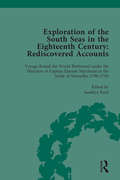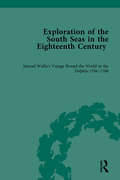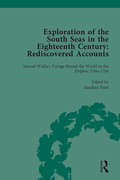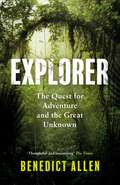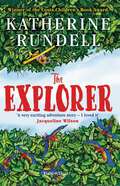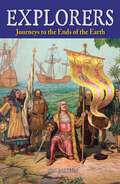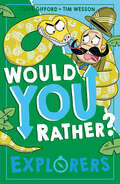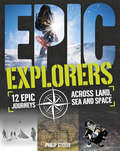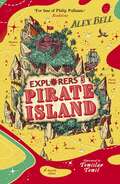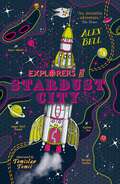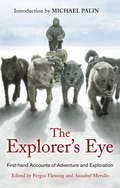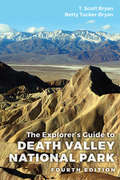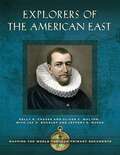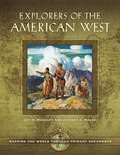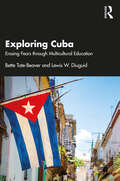- Table View
- List View
Exploration of the South Seas in the Eighteenth Century: Voyage Round the World Performed under the Direction of Captain Etienne Marchand in the Solide of Marseilles 1790-1792 (Routledge Historical Resources)
by Sandhya PatelThe publication of key voyaging manuscripts has contributed to the flourishing of enduring and prolific worldwide scholarship across numerous fields. These navigators and their texts were instrumental in spurring on further exploration, annexation and ultimately colonisation of the pacific territories in the space of only a few decades. This series will present new sources and primary texts in English, paving the way for postcolonial critical approaches in which the reporting, writing, rewriting and translating of Empire and the ‘Other’ takes precedence over the safeguarding of master narratives. Each of the volumes contains an introduction that sets out the context in which these voyages took place and extensive annotations clarify and explain the original texts. The translated accounts of voyages undertaken by foreign vessels abounded in an era when they encouraged not only competitive geopolitical initiatives but also commercial enterprises throughout Europe, resulting in a voluminous textual corpus. However, French merchant-seaman Etienne Marchand’s journal of his voyage round the world in 1790-1792, encompassing an important visit to the Marquesas Archipelago during his first crossing of the Pacific, remained unpublished until 2005 and has only now been made available in English. The second volume of this series comprises an annotated translation in English of this document.
Exploration of the South Seas in the Eighteenth Century: Rediscovered Accounts
by Sandhya PatelThe publication of key voyaging manuscripts has contributed to the flourishing of enduring and prolific worldwide scholarship across numerous fields. These navigators and their texts were instrumental in spurring on further exploration, annexation and ultimately colonisation of the Pacific territories in the space of only a few decades. This series will present new sources and primary texts in English, paving the way for postcolonial critical approaches in which the reporting, writing, rewriting and translating of Empire and the ‘Other’ takes precedence over the safeguarding of master narratives. Each of the volumes contains an introduction that sets out the context in which these voyages took place and extensive annotations clarify and explain the original texts. The first volume makes available Samuel Wallis’ logs of the Dolphin’s voyage 1766-68 in their original form for the first time. Captain Samuel Wallis was the first Englishman to come across the Tuamotus and the Society Isles in the South Pacific, specifically Tahiti. His writings predate the available textual sources by Louis-Antoine de Bougainville, the log of the Spanish voyages and James Cook — whose text Wallis’ prefigures. The three logs attest to the very first encounter between Europeans and Tahitians, but until now comparatively little research has been conducted on the more elaborate second volume and none on the first. The Polynesian archipelagos grew into objects of discourse over the years and Wallis' logs may very well be located at the heart of these evocative constructs. The translated accounts of voyages undertaken by foreign vessels abounded in an era when they encouraged not only competitive geopolitical initiatives but also commercial enterprises throughout Europe, resulting in a voluminous textual corpus. However, French merchant-seaman Etienne Marchand’s journal of his voyage round the world in 1790-1792, encompassing an important visit to the Marquesas Archipelago during his first crossing of the Pacific, remained unpublished until 2005 and has only now been made available in English. The second volume of this series comprises an annotated translation in English of this document.
Exploration of the South Seas in the Eighteenth Century: Voyage Round the World Performed under the Direction of Captain Etienne Marchand in the Solide of Marseilles 1790-1792 (Routledge Historical Resources)
by Sandhya PatelThe publication of key voyaging manuscripts has contributed to the flourishing of enduring and prolific worldwide scholarship across numerous fields. These navigators and their texts were instrumental in spurring on further exploration, annexation and ultimately colonisation of the pacific territories in the space of only a few decades. This series will present new sources and primary texts in English, paving the way for postcolonial critical approaches in which the reporting, writing, rewriting and translating of Empire and the ‘Other’ takes precedence over the safeguarding of master narratives. Each of the volumes contains an introduction that sets out the context in which these voyages took place and extensive annotations clarify and explain the original texts. The translated accounts of voyages undertaken by foreign vessels abounded in an era when they encouraged not only competitive geopolitical initiatives but also commercial enterprises throughout Europe, resulting in a voluminous textual corpus. However, French merchant-seaman Etienne Marchand’s journal of his voyage round the world in 1790-1792, encompassing an important visit to the Marquesas Archipelago during his first crossing of the Pacific, remained unpublished until 2005 and has only now been made available in English. The second volume of this series comprises an annotated translation in English of this document.
Exploration of the South Seas in the Eighteenth Century: Samuel Wallis’s Voyage Round the World in the Dolphin 1766-1768 (Routledge Historical Resources)
by Sandhya PatelThe publication of key voyaging manuscripts has contributed to the flourishing of enduring and prolific worldwide scholarship across numerous fields. These navigators and their texts were instrumental in spurring on further exploration, annexation and ultimately colonisation of the pacific territories in the space of only a few decades. This series will present new sources and primary texts in English, paving the way for postcolonial critical approaches in which the reporting, writing, rewriting and translating of Empire and the ‘Other’ takes precedence over the safeguarding of master narratives. Each of the volumes contains an introduction that sets out the context in which these voyages took place and extensive annotations clarify and explain the original texts. The first volume makes available Samuel Wallis’ logs of the Dolphin’s voyage 1766-68 in their original form for the first time. Captain Samuel Wallis was the first Englishman to come across the Tuamotus and the Society Isles in the South Pacific, specifically Tahiti. His writings predate the available textual sources by Louis-Antoine de Bougainville, the logs of the Spanish voyages and James Cook — whose text Wallis’ prefigures. The three logs attest to the very first encounter between Europeans and Tahitians, but until now comparatively little research has been conducted on the more elaborate second volume and none on the first. The Polynesian archipelagos grew into objects of discourse over the years and Wallis' logs may very well be located at the heart of these evocative constructs.
Explorer: The Quest for Adventure and the Great Unknown
by Benedict AllenWhat does it mean to be an explorer in the twenty-first century? This is the story of what first led Benedict Allen to head for the farthest reaches of our planet – at a time when there were still valleys and ranges known only to the remote communities who inhabited them. It is also the story of why, thirty years later, he is still exploring. Benedict decides to journey back to a clouded mountain in New Guinea to find an old friend called Korsai, and to fulfil a promise they made as young men. Explorer tells the story of what it means to be ‘lost’ and ‘found’.
The Explorer
by Katherine RundellGo on an adventure with Katherine Rundell ...Winner of the Children's Book PrizeWinner of the Costa Children's Book Award 2017Winner of the London Book Fair Children's Travel Book of the Year'I loved The Explorer' Jacqueline Wilson'Rundell is now unarguably in the FIRST RANK' Philip Pullman'Read everything she writes' Daily MailFrom his seat in the tiny aeroplane, Fred watches as the mysteries of the Amazon jungle pass by below him. He has always dreamed of becoming an explorer, of making history and of reading his name amongst the lists of great discoveries. If only he could land and look about him.As the plane crashes into the canopy, Fred is suddenly left without a choice. He and the three other children may be alive, but the jungle is a vast, untamed place. With no hope of rescue, the chance of getting home feels impossibly small.Except, it seems, someone has been there before them …
The Explorer and the Journalist: Frederick Cook, Philip Gibbs and the Scandal that Shocked the World
by Richard EvansOn 1 September 1909, a telegram from American explorer Frederick Cook caused perhaps the biggest sensation in polar exploration history. With no word from Cook for over a year and many assuming he was dead, here came the news that not only had he survived his Arctic expedition, but he had claimed one of the great prizes in exploration by becoming the first person to reach the North Pole.Cook was instantly transformed into one of the heroes of the age. And with his boat due to arrive in Copenhagen a few days later, the world’s journalists scrambled to get there in time to meet him. One of those journalists was Philip Gibbs, a young reporter for the Daily Chronicle in London, who had a chance encounter in a Copenhagen café that led to him getting an exclusive interview with Cook before he reached land. But Gibbs left the interview doubting Cook’s story, and so in his subsequent article he decided to gamble both his career and his reputation by making it clear he thought Cook might be lying.Gibbs’s article made him the most unpopular man in Copenhagen, and marked the start of a frantic six days during which Copenhagen showered Cook with accolades while Gibbs tried to prove his claim was untrue. The Explorer and the Journalist is the story of the explorer who was determined to prove he really had reached the Pole, and the journalist who was convinced he was a fraud. It was a confrontation from which only one of them would emerge with his reputation intact…
Explorers: Journeys to the Ends of the Earth
by Jon BalchinFascinated by what lies beyond the boundaries of human experience, men and women have throughout history been irresisibly drawn to venture into the unknown. Explorers charts the astonishing feats of history's most intrepid pathfinders. From the early voyages of the Ancient Greek mariner Colaeus, who first discovered that beyond the Mediterranean lay a far greater ocean, to the compelling tale of the race for the poles. this book encompasses the discovery and exploration of the great continents and oceans of the world. Whether motivated by the prospect of conquest, the spirit of scientific inquiry, nationalism, fanaticism, or just plain curiosity, the explorers in this book dared to seek out the most remote and inhospitable places on Earth and in so doing changed forever our perception of the planet.
Explorers (Would You Rather? #4)
by Clive GiffordWould you rather ride a hot-air balloon to the North Pole or cycle to the South Pole? Go to the toilet inside your spacecraft, or outside it? Only you can decide!
Explorers: Explorers (Epic! #1)
by Philip SteeleEpic: Explorers focuses on 12 of the most incredible expeditions in history, from the ancient Egyptian voyage to the land of Punt around 1470 BCE to the Apollo mission to space in 1969; taking in Marco Polo's journey to China, the great 15th-century Chinese voyages, the Portuguese sailing around the Cape of Good Hope, the New World voyages, the circumnavigation of the globe, the mapping of the Pacific, the exploration of the American West, the exploration of Africa, the race to the South Pole and the descent into the Mariana Trench on the way.The book details the dates and location of each expedition, the people involved and the distances travelled. A timeline on every spread gives the key dates from each expedition, and what happened when. Additional background information to each expedition leader is also provided, including Hatshepsut, Marco Polo, Zheng He, Christopher Columbus, Bartolomeu Dias, Vasco da Gama, Ferdinand Magellan, Captain James Cook, Meriwether Lewis, William Clark, Dr Livingstone, Henry Morton Stanley, Mary Kingsley, Robert Scott, Roald Amundsen, Jacques Picard, James Cameron, Neil Armstrong, Michael Collins and Buzz Aldrin.Epic: Explorers also looks at the technology and vehicles involved in each expedition, from the Chinese treasure ships and the American canoes to the skis and dog sleds used on the South Pole expedition, and the rocket that carried the astronauts to the Moon. The dangers the adventurers faced are also catalogued, from the deserts, robbers and storms Marco Polo braved on his journey to China, to the lions, crocodiles and diseases Stanley and Livingstone battled in Africa.Infographic elements on each spread present information in a simple and highly visual way. Clear, concise text and a bright, appealing design make the book the perfect resource for project work on exploration, geography or history, or simply a great leisure read, for children aged 9 and above.For more epic events, try reading the other titles in the Epic series: Animal Migrations, Battles and Empires.
Explorers at Pirate Island (The Explorers' Clubs #5)
by Alex BellIn their fifth thrilling adventure, the explorers journey deep into the Bubble Ocean on their quest to stop the evil Collector, but time is running out . . .The Poison Tentacle Sea was home to the powerful Bone Current. As they had feared, it gave a sudden surge and pulled them in.Half-mermaid Ursula Jellyfin has always longed for adventure, and this time the stakes are higher than ever. The Collector is holding a group of children prisoner on Pirate Island, and it's up to Ursula and her friends Jai, Max and Genie to set them free. Armed with a magical mermaid trident, and with new recruit Zara the pirate fairy on board, their mission is filled with danger. The explorers must face zombie skeletons, make a daring rescue from a whirlpool and travel through a dinosaur graveyard. But even if they do make it to Pirate Island, can they fool the Collector and get in to an impenetrable fort?Fast-paced, magical storytelling in a breathtaking underwater world. Alex Bell's inventiveness and attention to detail is a joy to read.Praise for the series:'A magical adventure of friendship, bravery and derring-do in a richly imagined world.' The Bookseller'A fantastic frosty adventure.' Sunday Express'Wintry, atmospheric, highly imaginative fantasy.' Metro'The most huggable book of the year . . . An (iced) gem.' SFX
Explorers at Stardust City (The Explorers' Clubs #6)
by Alex BellDirectly below was a sight none of them had ever seen before - a kind of spiral, with glowing ruby-red lights that curved outwards like tentacles.In the middle was a dark circle, inky black. It had the look of a really, really deep well.Ursula and her friends are in a race against time. The Collector has taken Stella captive, and is hungrily snatching up all the beautiful places of the world in her snow globe prisons. She needs to be stopped, but first they must find her.To aid them in their quest, the explorers seek help from new allies, including a Pirate Queen, with a ghost ship that can defy time and space, and then take to the skies in a galaxy fairy rocket. But their journey is fraught with danger, as the future of the planet hangs in the balance.Escape into a sensational world filled with space moles, sea goblins and giant sharks, all covered with a sprinkling of moon dust!
The Explorer's Eye: First-hand Accounts Of Adventure And Exploration
by Fergus FlemingThe golden moments of exploration and adventure - glorious, triumphant, perilous and dramatic. In the 18th century, exploration entered a new dimension - explorers were motivated by scientific inquiry rather than greed. To this end they were expected to make a full record of everything they encountered; and for the first time in history, that record was to include pictures as well as words. Combining gripping first-hand accounts with original images, THE EXPLORER'S EYE gives an insight into who these people were and what they saw. They were a mixed bunch but, whatever their training or background, they provided a vivid portrait of the unknown. In the early days they drew their own pictures, later they were equipped with draughtsmen, later still they carried cameras, and ultimately they were accompanied by film crews. The power of their images is matched by that of their journals. Here you have Alexander von Humboldt braving the electric eels of South America and Robert Peary explaining his relationships with Eskimos.
The Explorer's Guide to Death Valley National Park, Fourth Edition
by T. Scott Bryan Betty Tucker BryanOriginally published in 1995, soon after Death Valley National Park became the fifty-third park in the US park system, The Explorer’s Guide to Death Valley National Park was the first complete guidebook available for this spectacular area. Now in its fourth edition, this is still the only book that includes all aspects of the park. Much more than just a guidebook, it covers the park’s cultural history, botany and zoology, hiking and biking opportunities, and more. Information is provided for all of Death Valley’s visitors, from first-time travelers just learning about the area to those who are returning for in-depth explorations. This new edition features a number of important changes—including information on the boundary and wilderness changes that resulted from the Dingell Act of 2019, the reopened Keane Wonder Mine area, the devastating flash flooding of Scotty’s Castle, scenic river designations, the Inn and Ranch resorts, renovated and now operated as the Oasis at Death Valley—as well as new maps and updated color photos. With extensive input from National Park Service resource management, law enforcement, and interpretive personnel, as well as a thorough bibliography for suggested reading, The Explorer’s Guide to Death Valley National Park, Fourth Edition is the most up-to-date, accurate, and comprehensive guide available for this national treasure.
The Explorer's Guide to Death Valley National Park, Third Edition
by T. Scott Bryan Betty Tucker-BryanOriginally published in 1995, soon after Death Valley National Park became the fifty-third park in the US park system, The Explorer's Guide to Death Valley National Park was the first complete guidebook available for this spectacular area. Now in its third edition, this is still the only book that includes all aspects of the park. Much more than just a guidebook, it covers the park's cultural history, botany and zoology, hiking and biking opportunities, and more. Information is provided for all of Death Valley's visitors, from first-time travelers just learning about the area to those who are returning for in-depth explorations. The book includes updated point-to-point logs for every road within and around the park, as well as more accurate maps than those in any other publication. With extensive input from National Park Service resource management, law enforcement, and interpretive personnel, as well as a thorough bibliography for suggested reading, The Explorer's Guide to Death Valley National Park, Third Edition is the most up-to-date, accurate, and comprehensive guide available for this national treasure.
Explorers of the American East: Mapping the World through Primary Documents (Mapping the World through Primary Documents)
by Kelly K. Chaves Oliver C. WaltonFocusing on ten key figures whose careers illuminate the history of the European exploration of North America, this book presents compelling first-person narratives that bring to life the challenges of historical scholarship in the academic classroom.Explorers of the American East: Mapping the World through Primary Documents covers 280 years of North American exploration and colonization efforts, ranging geographically from Florida to the Arctic. Arranged thematically and mononationally, the work focuses on a selection of 10 explorers who represent the changing course of North American exploration during the early modern period. The use of biography to narrate this history draws in readers and makes the work accessible to both a specialized and general audience. The dozens of primary source documents in this guided source reader span travel accounts, autobiographies, letters, official reports, memoirs, patents, and articles of agreement. This wide variety of primary sources serves to bring to life the failures and triumphs of exploring a newly discovered continent in the early modern period.This work focuses on ten explorers, including those who are well known, including John Cabot, John Smith, Jacques Cartier, and Samuel de Champlain, as well as discoverers who have slipped from our modern historical consciousness, such as George Waymouth, John Lawson, and J.F.W. Des Barres. The documents that narrate the voyages of these adventurers are arranged chronologically, vividly telling the story of historical events and presenting different voices to the reader. This variety of viewpoints serves to heighten readers' critical engagement with historical source material. The vast variety of primary source materials present students with the opportunity to read and engage critically with different types of historical documents, thereby growing their analytical skillsets.
Explorers of the American East: Mapping the World through Primary Documents (Mapping the World through Primary Documents)
by Kelly K. Chaves Oliver C. WaltonFocusing on ten key figures whose careers illuminate the history of the European exploration of North America, this book presents compelling first-person narratives that bring to life the challenges of historical scholarship in the academic classroom.Explorers of the American East: Mapping the World through Primary Documents covers 280 years of North American exploration and colonization efforts, ranging geographically from Florida to the Arctic. Arranged thematically and mononationally, the work focuses on a selection of 10 explorers who represent the changing course of North American exploration during the early modern period. The use of biography to narrate this history draws in readers and makes the work accessible to both a specialized and general audience. The dozens of primary source documents in this guided source reader span travel accounts, autobiographies, letters, official reports, memoirs, patents, and articles of agreement. This wide variety of primary sources serves to bring to life the failures and triumphs of exploring a newly discovered continent in the early modern period.This work focuses on ten explorers, including those who are well known, including John Cabot, John Smith, Jacques Cartier, and Samuel de Champlain, as well as discoverers who have slipped from our modern historical consciousness, such as George Waymouth, John Lawson, and J.F.W. Des Barres. The documents that narrate the voyages of these adventurers are arranged chronologically, vividly telling the story of historical events and presenting different voices to the reader. This variety of viewpoints serves to heighten readers' critical engagement with historical source material. The vast variety of primary source materials present students with the opportunity to read and engage critically with different types of historical documents, thereby growing their analytical skillsets.
Explorers of the American West: Mapping the World through Primary Documents (Mapping the World through Primary Documents)
by Jay H. Buckley Jeffery D. NokesWith original primary source documents, this anthology brings readers into the vast unknown 19th-century American West—through the eyes of the explorers who saw it for the first time.This volume brings together book excerpts, maps, and illustrations from 12 explorers from the 19th century, highlighting their lives and contributions. Arranged chronologically, the 10 chapters focus on individual explorers, with biographies and background information about and document excerpts from each person. The chapters offer analyses of each document's relevance to the historical period, geographic knowledge, and cultural perspective. This guide shares the important contributions from explorers like Lewis and Clark, Zebulon Pike, Jedediah Smith, James P. Beckwourth, John C. Fremont, Susan Magoffin, and John Wesley Powell. It also nurtures readers' historical literacy by modeling historians' methods of analyzing primary sources. Readers will see new and familiar events from different perspectives, including that of a woman traveling along the Santa Fe Trail, one of the most famous African American mountain men, and a Civil War veteran, among many others.
Explorers of the American West: Mapping the World through Primary Documents (Mapping the World through Primary Documents)
by Jay H. Buckley Jeffery D. NokesWith original primary source documents, this anthology brings readers into the vast unknown 19th-century American West—through the eyes of the explorers who saw it for the first time.This volume brings together book excerpts, maps, and illustrations from 12 explorers from the 19th century, highlighting their lives and contributions. Arranged chronologically, the 10 chapters focus on individual explorers, with biographies and background information about and document excerpts from each person. The chapters offer analyses of each document's relevance to the historical period, geographic knowledge, and cultural perspective. This guide shares the important contributions from explorers like Lewis and Clark, Zebulon Pike, Jedediah Smith, James P. Beckwourth, John C. Fremont, Susan Magoffin, and John Wesley Powell. It also nurtures readers' historical literacy by modeling historians' methods of analyzing primary sources. Readers will see new and familiar events from different perspectives, including that of a woman traveling along the Santa Fe Trail, one of the most famous African American mountain men, and a Civil War veteran, among many others.
Explorers of the Nile: The Triumph and Tragedy of a Great Victorian Adventure (Playaway Adult Nonfiction Ser.)
by Tim JealBetween 1856 and 1876, five explorers, all British, took on the seemingly impossible task of discovering the source of the White Nile. Showing exceptional courage and extraordinary resilience, Richard Burton, John Hanning Speke, Samuel Baker, David Livingstone and Henry Morton Stanley risked their lives and their reputations in the name of this quest. They journeyed through East and Central Africa into unmapped territory, discovered the great lakesTanganyika and Victoria, navigated the upper Nile and the Congo, and suffered the ravages of flesh-eating ulcers, malaria and deep spear wounds. Using new research, Tim Jeal tells the story of these great expeditions, while also examining the tragic consequences which the Nile search has had on Uganda and Sudan to this day.Explorers of the Nile is a gripping adventure story with an arresting analysis of Britain's imperial past and the Scramble for Africa.
Exploring Community Festivals and Events (Routledge Advances in Event Research Series)
by Allan Jepson Alan ClarkeThe development of the festival and event industry has seen large scale growth and extensive government support as a result of objectives to enhance and project the image of place and leverage positive sponsorship and regeneration opportunities. As we move deeper into austerity measures prompted by economic recession, community festivals and events as a sacred or profane time of celebration can be considered even more important than ever before. This book for the first time explores the role and importance of ‘community’, ‘culture’ and its impact through festivals and events. Split into two distinct sections, the first introduces key themes and concepts, contextualises local traditions and culture, and investigates how festivals and events can act as a catalyst for tourism and create a sense of community. It then questions the social and political nature of festivals and community events through examining their ownership. The second section focuses on communities themselves, seeking to examine and discuss key emerging themes in community event studies such as; the role of diaspora, imagined communities, pride and identity, history, producing and consuming space and place, authenticity, and multi-ethnic communities. Examples are drawn from Portugal, the Dominican Republic, the USA, Malaysia, Malta, Finland and Australia making this book truly international. This significant volume will be valuable reading for students and academics across the fields of Event, Tourism and Hospitality studies as well as other social science disciplines.
Exploring Community Festivals and Events (Routledge Advances in Event Research Series)
by Allan Jepson Alan ClarkeThe development of the festival and event industry has seen large scale growth and extensive government support as a result of objectives to enhance and project the image of place and leverage positive sponsorship and regeneration opportunities. As we move deeper into austerity measures prompted by economic recession, community festivals and events as a sacred or profane time of celebration can be considered even more important than ever before. This book for the first time explores the role and importance of ‘community’, ‘culture’ and its impact through festivals and events. Split into two distinct sections, the first introduces key themes and concepts, contextualises local traditions and culture, and investigates how festivals and events can act as a catalyst for tourism and create a sense of community. It then questions the social and political nature of festivals and community events through examining their ownership. The second section focuses on communities themselves, seeking to examine and discuss key emerging themes in community event studies such as; the role of diaspora, imagined communities, pride and identity, history, producing and consuming space and place, authenticity, and multi-ethnic communities. Examples are drawn from Portugal, the Dominican Republic, the USA, Malaysia, Malta, Finland and Australia making this book truly international. This significant volume will be valuable reading for students and academics across the fields of Event, Tourism and Hospitality studies as well as other social science disciplines.
Exploring Cuba: Erasing Fears through Multicultural Education
by Bette Tate-Beaver Lewis W. DiuguidExploring Cuba: Erasing Fears Through Multicultural Education details the cultural and professional exchanges to Cuba organized by the National Association of Multicultural Education (NAME) between 2015 and 2019, with additional reflections on the impact of the coronavirus pandemic on Cuba—U.S. relations. Because of the long-imposed U.S. embargo, or blockade, access to information about life in Cuba can be limited in the U.S. This book chronicles first-hand account of NAME’s trips to Cuba over a 5-year period. Interspersed with insights from U.S.-based multicultural educators, authors and Cuban delegates, it documents what NAME members learned about Cuba’s people, history, health care system, culture, arts, and education systems. It also explores the effects of the coronavirus global pandemic on Cuba and its vital tourist industry, as well as the July 2021 protests and aftermath, including a new wave of immigration to the U.S. The book argues for the end of the U.S. embargo with Cuba and the normalization of diplomatic relations between the two countries, so that unrestricted tourism and trade can benefit both countries. Combining travelogue observations with statistics and scholarly accounts, this volume will be useful reading for scholars and students of Multicultural Education, International Education and Comparative Education. It will also be beneficial to educators and Cuba solidarity activists.
Exploring Cuba: Erasing Fears through Multicultural Education
by Bette Tate-Beaver Lewis W. DiuguidExploring Cuba: Erasing Fears Through Multicultural Education details the cultural and professional exchanges to Cuba organized by the National Association of Multicultural Education (NAME) between 2015 and 2019, with additional reflections on the impact of the coronavirus pandemic on Cuba—U.S. relations. Because of the long-imposed U.S. embargo, or blockade, access to information about life in Cuba can be limited in the U.S. This book chronicles first-hand account of NAME’s trips to Cuba over a 5-year period. Interspersed with insights from U.S.-based multicultural educators, authors and Cuban delegates, it documents what NAME members learned about Cuba’s people, history, health care system, culture, arts, and education systems. It also explores the effects of the coronavirus global pandemic on Cuba and its vital tourist industry, as well as the July 2021 protests and aftermath, including a new wave of immigration to the U.S. The book argues for the end of the U.S. embargo with Cuba and the normalization of diplomatic relations between the two countries, so that unrestricted tourism and trade can benefit both countries. Combining travelogue observations with statistics and scholarly accounts, this volume will be useful reading for scholars and students of Multicultural Education, International Education and Comparative Education. It will also be beneficial to educators and Cuba solidarity activists.
Exploring Desert Stone: John N. Macomb's 1859 Expedition to the Canyonlands of the Colorado
by Steven K. MadsenThe confluence of the Green and Colorado Rivers, now in Canyonlands National Park, near popular tourist destination Moab, still cannot be reached or viewed easily. Much of the surrounding region remained remote and rarely visited for decades after settlement of other parts of the West. The first U.S. government expedition to explore the canyon country and the Four Corners area was led by John Macomb of the army's topographical engineers. The soldiers and scientists followed in part the Old Spanish Trail, whose location they documented and verified. Seeking to find the confluence of the Colorado and the Green and looking for alternative routes into Utah, which was of particular interest in the wake of the Utah War, they produced a substantial documentary record, most of which is published for the first time in this volume. Theirs is also the first detailed map of the region, and it is published in Exploring Desert Stone, as well.
